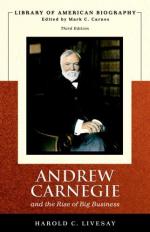
|
| Name: _________________________ | Period: ___________________ |
This test consists of 15 multiple choice questions and 5 short answer questions.
Multiple Choice Questions
1. What does Andrew dislike about the oil business that seems beyond control of management until the 1880s and Rockefeller?
(a) The instability of the economy.
(b) The destructive properties of oil.
(c) The smell, messiness and waste.
(d) The fluctuation of price.
2. In ___________, Andrew is offered a job by Tom Scott, western division superintendent of the Pennsylvania Railroad, to be his secretary and personal telegrapher.
(a) 1862.
(b) 1852.
(c) 1858.
(d) 1868.
3. Carnegie promotes expanding with other Pennsylvania-controlled franchises through Scott and assures construction in his contracting business by bartering Pacific stock for construction costs with ___________ exchange rates.
(a) 2 and 4 to one.
(b) 3 and 4 to one.
(c) 3 and 5 to one.
(d) 5 and 7 to one.
4. Carnegie sells Central patents for ____________ to Pullman and they exchange shares for no money to form the new company.
(a) $200,000.
(b) $20,000.
(c) $200.
(d) $2,000.
5. Carnegie presents the bonds to the Morgan investment banking house in London in March, 1869, where he sells them to Morgan at what percent?
(a) 75.
(b) 85.
(c) 65.
(d) 55.
6. Margaret Carnegie's sister precedes her move to America and Annie Aitken provides them what?
(a) Low-rent housing.
(b) Rent-free housing.
(c) Food.
(d) Employment.
7. Except for Tom, the youngest who is in school, Will and Margaret go to work by weaving and shoe-binding, and Andrew as what in a textile mill?
(a) A shoe-binder.
(b) A weaver.
(c) A bobbin boy.
(d) An errand boy.
8. Carnegie proposes they cooperate rather than bid against each other and suggests what be the joint venture?
(a) "The Carnegie Car Company."
(b) "The Pullman Sleeper Car Company."
(c) "The Pullman Palace Car Company."
(d) "The Pullman-Carnegie Car Company."
9. Coleman wants to raise the price of oil by doing what?
(a) Raising the cost of shipping.
(b) Raising his own salary.
(c) Raising his workers' salaries.
(d) Hoarding supply.
10. Carnegie's first dividend check for ________ opens a whole new world of receiving cash from capital.
(a) $40.
(b) $10.
(c) $80.
(d) $20.
11. How many people immigrate from the Old to the New World to embed the dream into an image of America far stronger than the success of a few like the Guggenheims and Vanderbilts?
(a) Tens of millions.
(b) Tens of billions.
(c) Tens of thousands.
(d) Hundreds.
12. Who is Cuban Roberto Goizuetta?
(a) The deceased CEO of Intel.
(b) The deceased chairman of Coca-Cola.
(c) The deceased president of Liz Claiborne.
(d) The deceased chairman of Applebee's.
13. Pennsylvania Railroad buys from the Woodruff venture and offers what when borrowing?
(a) The credibility of a "strong corporation."
(b) A great deal of collateral.
(c) The credibility of a "big corporation."
(d) A discount on shipping.
14. Will is unable to catch on to new opportunities and reverts back to weaving and selling his wares on the street, which does what?
(a) Destroys his self-confidence and shames his family.
(b) Builds his self-confidence and brings pride to his family.
(c) Brings him more work than when he had his factory job.
(d) Provides a significant income for his family.
15. Carnegie meets railroad's ____________ and initiates control of division operations when needed.
(a) Customers.
(b) Executives.
(c) Critics.
(d) Managers.
Short Answer Questions
1. He forms an informal investing ____________ with Thomson and Scott.
2. Scott leaves Carnegie in charge when he does what?
3. Although Andrew dislikes the tedium, smells and hours, he works in another textile mill until what?
4. Andrew goes to night school in bookkeeping at what age?
5. Who is the cornerstone of Carnegie's fortune, followed in 1861 by Columbia Oil?
|
This section contains 549 words (approx. 2 pages at 300 words per page) |

|




